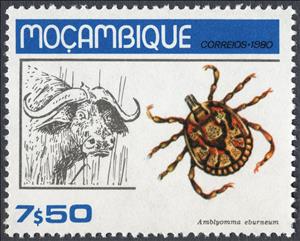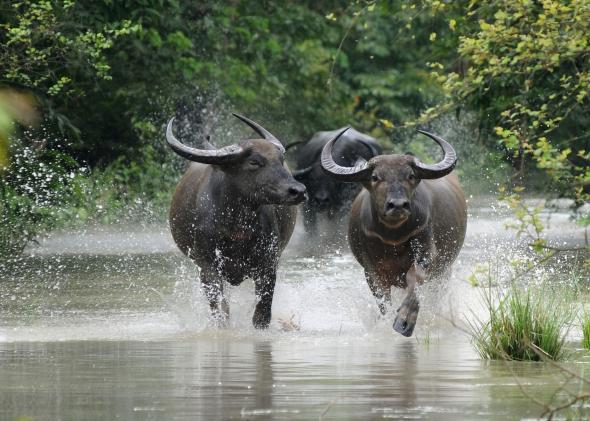Stamp: Tick (Amblyomma eburneum), African Buffalo (Syncerus caffer) (Mozambique 1980)
Tick (Amblyomma eburneum), African Buffalo (Syncerus caffer) (Mozambique 1980)
29 January (Mozambique ) within release Ticks and their host animals goes into circulation Stamp Tick (Amblyomma eburneum), African Buffalo (Syncerus caffer) face value 7.50 Mozambican escudo
| Stamp Tick (Amblyomma eburneum), African Buffalo (Syncerus caffer) in catalogues | |
|---|---|
| Michel: | Mi:MZ 742 |
Stamp is horizontal format.
Ticks of MozambiqueAlso in the issue Ticks and their host animals:
- Stamp - Hard Tick (Dermacentor circumguttatus cunhasilvai), African face value 50;
- Stamp - Tick (Dermacentor rhinocerinus), Rhinoceros face value 1.50;
- Stamp - South African Bont Tick (Amblyomma hebraeum), Giraffe (Giraf face value 2.50;
- Stamp - Star Bont Tick (Amblyomma pomposum), Eland (Taurotragus oryx face value 3;
- Stamp - Tick (Amblyomma theilerae), Cattle (Bos primigenius taurus) face value 5;
- Stamp - Tick (Amblyomma eburneum), African Buffalo (Syncerus caffer) face value 7.50;
Stamp Tick (Amblyomma eburneum), African Buffalo (Syncerus caffer) it reflects the thematic directions:
Mammals are any vertebrates within the class Mammalia (/məˈmeɪli.ə/ from Latin mamma "breast"), a clade of endothermic amniotes distinguished from reptiles (including birds) by the possession of a neocortex (a region of the brain), hair, three middle ear bones and mammary glands. All female mammals nurse their young with milk, secreted from the mammary glands. Mammals include the largest animals on the planet, the great whales. The basic body type is a terrestrial quadruped, but some mammals are adapted for life at sea, in the air, in trees, underground or on two legs. The largest group of mammals, the placentals, have a placenta, which enables the feeding of the fetus during gestation. Mammals range in size from the 30–40 mm (1.2–1.6 in) bumblebee bat to the 30-meter (98 ft) blue whale. With the exception of the five species of monotreme (egg-laying mammals), all modern mammals give birth to live young. Most mammals, including the six most species-rich orders, belong to the placental group. The largest orders are the rodents, bats and Soricomorpha (shrews and allies). The next three biggest orders, depending on the biological classification scheme used, are the Primates (apes and monkeys), the Cetartiodactyla (whales and even-toed ungulates), and the Carnivora (cats, dogs, seals, and allies).
Insects (from Latin insectum, a calque of Greek ἔντομον [éntomon], "cut into sections") are a class (Insecta) of hexapod invertebrates within the arthropod phylum that have a chitinous exoskeleton, a three-part body (head, thorax and abdomen), three pairs of jointed legs, compound eyes and one pair of antennae. They are the most diverse group of animals on the planet, including more than a million described species and representing more than half of all known living organisms. The number of extant species is estimated at between six and ten million, and potentially represent over 90% of the differing animal life forms on Earth. Insects may be found in nearly all environments, although only a small number of species reside in the oceans, a habitat dominated by another arthropod group, crustaceans. The life cycles of insects vary but most hatch from eggs. Insect growth is constrained by the inelastic exoskeleton and development involves a series of molts. The immature stages can differ from the adults in structure, habit and habitat, and can include a passive pupal stage in those groups that undergo 4-stage metamorphosis (see holometabolism). Insects that undergo 3-stage metamorphosis lack a pupal stage and adults develop through a series of nymphal stages. The higher level relationship of the Hexapoda is unclear. Fossilized insects of enormous size have been found from the Paleozoic Era, including giant dragonflies with wingspans of 55 to 70 cm (22–28 in). The most diverse insect groups appear to have coevolved with flowerin plants.
Animals are multicellular, eukaryotic organisms of the kingdom Animalia (also called Metazoa). All animals are motile, meaning they can move spontaneously and independently, at some point in their lives. Their body plan eventually becomes fixed as they develop, although some undergo a process of metamorphosis later on in their lives. All animals are heterotrophs: they must ingest other organisms or their products for sustenance.
Bubalina is a subtribe of wild cattle that includes the various species of true buffalo. Species include the African buffalo, the anoas, and the wild water buffalo (including the domesticated variant water buffalo). Buffaloes can be found naturally in sub-Saharan Africa, South Asia and Southeast Asia, and domestic and feral populations have been introduced to Europe, the Americas, and Australia.In addition to the living species, bubalinans have an extensive fossil record where remains have been found in much of Afro-Eurasia




